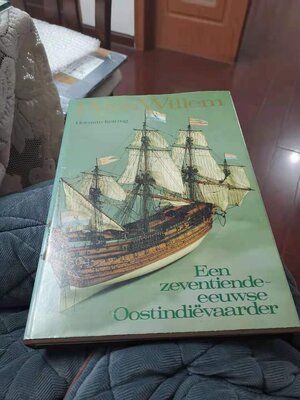Marvelous Heinrich. I'm so glad you came back to the Batavia/Haarlem! I share your interest in these Dutch-built ships and am learning a lot for my own build. Thanks for leading the way!
-

Win a Free Custom Engraved Brass Coin!!!
As a way to introduce our brass coins to the community, we will raffle off a free coin during the month of August. Follow link ABOVE for instructions for entering.
You are using an out of date browser. It may not display this or other websites correctly.
You should upgrade or use an alternative browser.
You should upgrade or use an alternative browser.
VOC SPIEGELRETOURSCHIP BATAVIA 1628 - KOLDERSTOK 1:72
- Thread starter Heinrich
- Start date
- Watchers 64
-
- Tags
- batavia kolderstok
Heinrich, very nicely done, As always your explanation of your progress is great. If I counted correctly that was four sheaves, so is it “four sheaves into the wind”? I never can get all those nautical terms right 
 Happy new year to you and Anna
Happy new year to you and Anna
Jan
 Happy new year to you and Anna
Happy new year to you and Anna
Jan
- Joined
- Jan 9, 2020
- Messages
- 10,534
- Points
- 938

@dockattner Thank you Paul - I really appreciate your comments. I wish I had the ability to emulate your painting skills ... but alas  . Yes the Dutch ships are very special Paul and there is a HUGE difference between their construction and way of operation than anything else. The problem is that on the 17th Century ships there really are no definitive plans available up until about 1680. A lot is guesswork and that makes it very difficult to try and bring one to market. And if - by chance - you do find plans then you have to fight the whole world for the right to use them.
. Yes the Dutch ships are very special Paul and there is a HUGE difference between their construction and way of operation than anything else. The problem is that on the 17th Century ships there really are no definitive plans available up until about 1680. A lot is guesswork and that makes it very difficult to try and bring one to market. And if - by chance - you do find plans then you have to fight the whole world for the right to use them.
- Joined
- Apr 20, 2020
- Messages
- 6,178
- Points
- 738

She's always in my mind@shota70 Hello my dear friend. Thank you for your very kind words - they are much appreciated. I miss you continuing your build on the Friesland. I know that Hannah is occupying all your time, but don't forget the Friesland!
- Joined
- Jan 9, 2020
- Messages
- 10,534
- Points
- 938

@Pathfinder65 Thank you for the compliments and for the New Year's wishes, Jan! Yes the English terminology is not my strong suit. But now we do know that the locking system of the capstan is called a pawl and the Dutch name is a "Blokkeersysteem" (Literally translated - Blocking System).
- Joined
- Jan 9, 2020
- Messages
- 10,534
- Points
- 938

That is good to hear my friend. I am glad that you have not forgotten about her!She's always in my mind
- Joined
- Jan 9, 2020
- Messages
- 10,534
- Points
- 938

Now that would be an absolutely wonderful gathering - can you imagine how much of an exchange of ideas will take place? And what an opportunity to show politicians all over the world what is really important in life!I am waiting and praying for the day when the corona plague will pass, and thet we will return to a normal life and we will finally be able to meet at a shipbuilding conference. It would be nicer, to meet all of you , my dear friends
Hi Heinrich,
Enjoy the Chinese New Year, and dont eat too much allthough that is very difficult in China as I know from experience.
Keep up the good work.
Enjoy the Chinese New Year, and dont eat too much allthough that is very difficult in China as I know from experience.
Keep up the good work.
- Joined
- Jan 9, 2020
- Messages
- 10,534
- Points
- 938

3 days of continuous hobby, enjoy.
Perfect, wrapped it as good as possible and it looks it did do the job.
- Joined
- Sep 1, 2020
- Messages
- 1
- Points
- 1
Pffff! Now you can hit an iceberg with your ship - and the iceberg will sink!
A lot of work - but it turned out quite well! (Except for the walnut keel part).
In the planking proces two options are possible in this stage:
1: Bend en mount the planking in a way it is a little bit too long so it goes a few mm over the false keel. Then - when your new keel part has arrived, use this as a template to draw the outlines (width) of the walnut keel onto the planks and cut away the ends of the planks so the keel fits exactly in between it.
2: or sand the planks nice flush in the rounding of the hull and cut out the thickness of the planks out of the new-to-arrive keel part so it fits over it.
And Ab Hoving is right when he says that balsa is no wood. In fact it is wood, but it is no real construction wood. It does not really add strenght or whatsoever to the hull. It merely gives you a good indication of how your planking should go and how the lines of the bow part go.
The bow of Dutch 17th century ships was quitte blunt (I don't know if this is the correct word for it), but I mean that the bow is very round shaped and therefore rather difficult to form. Once you have experienced the bending and gluing of the first planks you will appreciate the extra wood in front.
Hans
Looking good Heinrich! Enjoy your time off!
- Joined
- Mar 11, 2020
- Messages
- 213
- Points
- 143

Color combination looks good and your deck plankis wonderful.
Marcus
Marcus
- Joined
- Jan 9, 2020
- Messages
- 10,534
- Points
- 938

@flying_dutchman2 Thank you very much for the kind words, Marcus. It is much appreciated!




